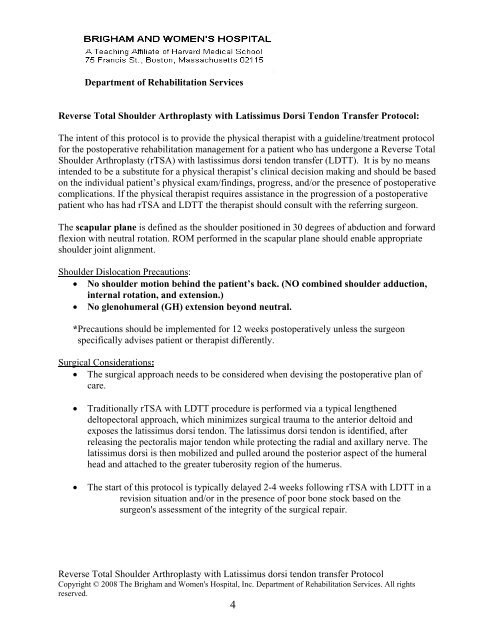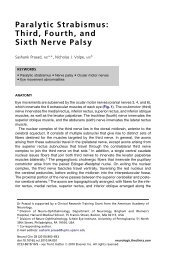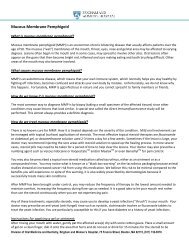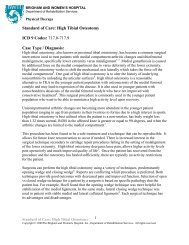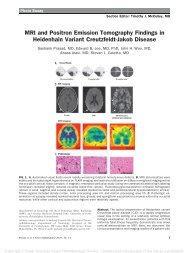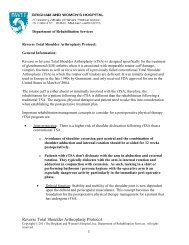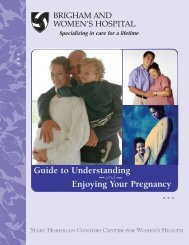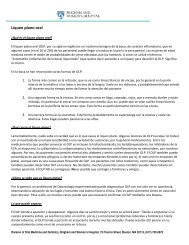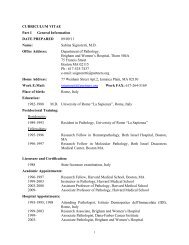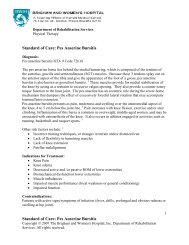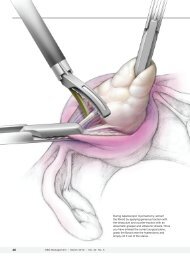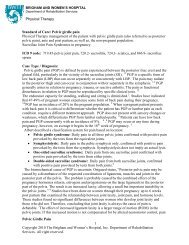Reverse TSA with LDTT Protocol - Brigham and Women's Hospital
Reverse TSA with LDTT Protocol - Brigham and Women's Hospital
Reverse TSA with LDTT Protocol - Brigham and Women's Hospital
Create successful ePaper yourself
Turn your PDF publications into a flip-book with our unique Google optimized e-Paper software.
Department of Rehabilitation Services<br />
<strong>Reverse</strong> Total Shoulder Arthroplasty <strong>with</strong> Latissimus Dorsi Tendon Transfer <strong>Protocol</strong>:<br />
The intent of this protocol is to provide the physical therapist <strong>with</strong> a guideline/treatment protocol<br />
for the postoperative rehabilitation management for a patient who has undergone a <strong>Reverse</strong> Total<br />
Shoulder Arthroplasty (r<strong>TSA</strong>) <strong>with</strong> lastissimus dorsi tendon transfer (<strong>LDTT</strong>). It is by no means<br />
intended to be a substitute for a physical therapist’s clinical decision making <strong>and</strong> should be based<br />
on the individual patient’s physical exam/findings, progress, <strong>and</strong>/or the presence of postoperative<br />
complications. If the physical therapist requires assistance in the progression of a postoperative<br />
patient who has had r<strong>TSA</strong> <strong>and</strong> <strong>LDTT</strong> the therapist should consult <strong>with</strong> the referring surgeon.<br />
The scapular plane is defined as the shoulder positioned in 30 degrees of abduction <strong>and</strong> forward<br />
flexion <strong>with</strong> neutral rotation. ROM performed in the scapular plane should enable appropriate<br />
shoulder joint alignment.<br />
Shoulder Dislocation Precautions:<br />
• No shoulder motion behind the patient’s back. (NO combined shoulder adduction,<br />
internal rotation, <strong>and</strong> extension.)<br />
• No glenohumeral (GH) extension beyond neutral.<br />
*Precautions should be implemented for 12 weeks postoperatively unless the surgeon<br />
specifically advises patient or therapist differently.<br />
Surgical Considerations:<br />
• The surgical approach needs to be considered when devising the postoperative plan of<br />
care.<br />
• Traditionally r<strong>TSA</strong> <strong>with</strong> <strong>LDTT</strong> procedure is performed via a typical lengthened<br />
deltopectoral approach, which minimizes surgical trauma to the anterior deltoid <strong>and</strong><br />
exposes the latissimus dorsi tendon. The latissimus dorsi tendon is identified, after<br />
releasing the pectoralis major tendon while protecting the radial <strong>and</strong> axillary nerve. The<br />
latissimus dorsi is then mobilized <strong>and</strong> pulled around the posterior aspect of the humeral<br />
head <strong>and</strong> attached to the greater tuberosity region of the humerus.<br />
• The start of this protocol is typically delayed 2-4 weeks following r<strong>TSA</strong> <strong>with</strong> <strong>LDTT</strong> in a<br />
revision situation <strong>and</strong>/or in the presence of poor bone stock based on the<br />
surgeon's assessment of the integrity of the surgical repair.<br />
<strong>Reverse</strong> Total Shoulder Arthroplasty <strong>with</strong> Latissimus dorsi tendon transfer <strong>Protocol</strong><br />
Copyright © 2008 The <strong>Brigham</strong> <strong>and</strong> <strong>Women's</strong> <strong>Hospital</strong>, Inc. Department of Rehabilitation Services. All rights<br />
reserved.<br />
4


